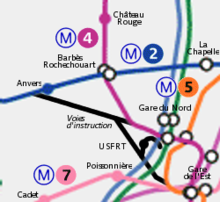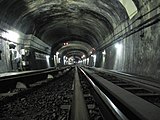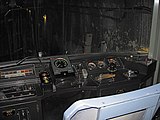Gare du Nord USFRT (Métro Paris)
| Gare du Nord USFRT | |
|---|---|
| Metro station in Paris | |
 Remaining platform with visitors on the occasion of the European Heritage Day in September 2007 |
|
| Basic data | |
| Arrondissement | 10th arrondissement |
| Opened | November 15, 1907 |
| Closed | October 12, 1942 |
| Coordinates | 48 ° 52 '45 " N , 2 ° 21' 16" E |
| use | |
| Line (s) | formerly |
The training center of the Paris Métro Unité spécialisée en formation et réglementation du transport (USFRT) at the Gare du Nord long-distance train station is located in tunnels and connecting lines in the 10th arrondissement of Paris that are no longer used for regular services . The centerpiece is the former terminus Gare du Nord of line 5 , which for a route extension in October 1942 by a new underground station was replaced. To distinguish it from the metro stations of the same name currently used for passenger operations , the facility is now referred to as Gare du Nord USFRT .
location
The former Gare du Nord underground station on line 5 is located in a tunnel under Boulevard de Denain , directly south of the station building. Originally equipped with two tracks, a central platform in between and accesses in the north and south, only the eastern mainline track still exists today. In the area of the station there is a maintenance pit in the track area. A large part of the former station area was structurally separated and now serves as space for the training center.
Under the forecourt of the long-distance train station, the Place Napoléon III , directly to the north of the metro station, the remnants of a former turning loop , which bend to the east, join, which is now used as a double-track parking facility .
South of the Gare du Nord USFRT, the single-track line branches off under the Place de Valenciennes into a connecting tunnel under the Boulevard de Magenta , which at the intersection with the Rue de Saint-Quentin in the south-east meets the line 5, which is used for regular services from here follows your new route.
To the north, the connecting tunnel runs on two tracks to the intersection with Rue de Dunkerque , where it branches off to the northwest and runs on a single track to the Anvers station on line 2 . Under the intersection of Dunkerque and Magenta there is also a connecting track to line 4 , which can only be used from the west.
Accesses
There were originally three entrances to the former subway station, as well as a transition to the long-distance train station and the line 4 station. While the southern staircase at Place de Valenciennes now serves as the entrance to the training center, the two northern entrances at Place Napoléon III are on both Pages of the Boulevard de Denain open to the public. Thanks to the connecting corridor branching off from the mezzanine floor there, they can now be used as additional entrances to the metro station on line 4. The stairs from the northern intermediate level to the USFRT platform are no longer freely accessible.
training centre
In the tunnel under the Boulevard de Magenta there are two provisionally installed training platforms named Gare du Nord and Gare de l'Est , to the northwest and southeast of the Place de Valenciennes . Like the former turning loop, the second track in the connecting tunnel can be used to park trains. The former metro station on line 5 bears the name Bastille for the training company . There is also the fictitious Republique station at the intersection under Place de Valenciennes and the Anvers exercise station in the tunnel under Rue de Dunkerque . These are represented by markings and station signs on the wall. In addition, there are various signals throughout the facility for the practice .
USFRT track plan not north- facing: The former underground station is labeled “Fosse QD”, the parking facility in the loop is labeled “Trottoir”
Rolling stock
The training center has its own vehicles for instruction drives, which are also parked in the area of the training facility. The vehicle fleet usually consists of decommissioned cars from the oldest rail-bound vehicle series .
For years the stainless steel prototype W2 of the MF 67 series - the so-called "Zébulon" - supplied with corrugated side walls , was at home in the USFRT. Due to extensive damage caused by vandalism, the pre-series train delivered in 1968 and used in passenger traffic for around twelve years (with the exception of the M 10004 railcar) was scrapped in 2011. The two aluminum prototypes C1A (004) and the C2A (003), known as Bonbonnière because of its pink interior , were also used in the training center. While the latter came into regular service again in the early 2000s , the C1A shared the fate of the "Zébulon" in 2011.
Later, two MF 67 D (numbers 3060 and 3072) withdrawn from line 9 were used on the training facility. 3060 was finally withdrawn from the USFRT and converted as a test vehicle for the introduction of the OCTYS system at the Porte de Charenton station . After this task was taken over by an MF-01 train (number 049), the 3060 was scrapped in July 2011.
There are currently six retired MF 67 E trains from Line 2 for the training center (numbers 311, 314G, 320G, 331, 341 and 349).
Since they are no longer used in passenger transport, the passenger seats in the USFRT trains have been removed.
history
Terminal station of line 5 (until 1942)
After line 5 was extended from Lancry station (since 1946: Jacques Bonsergent ) via Gare de l'Est to Gare du Nord on November 15, 1907 , today's USFRT station was the northern end of the line until October 12, 1942 .
From Gare de l'Est, line 5 runs parallel to line 7 under Rue 8 Mai 1945 . At the intersection with Boulevard de Magenta , line 5 branches off, while line 7 continues straight under Rue de Chabrol . Line 5 follows Boulevard de Magenta to the junction with Rue de Saint-Quentin , under which it continues north. At the intersection with Rue la Fayette , today's route of line 5 branches off from the old turning loop. This led under the Rue de Saint-Quentin further north to the forecourt of the long-distance train station Gare du Nord. With a 180-degree curve under Place Napoléon III , the route turns into Boulevard de Denain , where the former terminus was reached. From there it went back to the Gare de l'Est via the Boulevard de Magenta .
Extension of line 5 to Pantin (from 1942)
Due to the extension to Église de Pantin , the line had to be relocated in the area of the north station, so that the old metro station became superfluous and was replaced by a new system southeast of the Gare du Nord.
Partial demolition of the turning loop in favor of the RER expansion
The turning loop of line 5, immediately northeast of the former underground station , was demolished in the late 1970s during the construction of the tunnel for RER lines B and D between Châtelet - Les Halles and Gare du Nord. The destroyed section is between the intersection of Rue Saint-Quentin and Rue La Fayette and the intersection of Rue Saint-Quentin and Rue de Dunkerque .
See also
Individual evidence
- ↑ Interactive track plan of the Paris metro network , accessed on February 8, 2013.
- ↑ Illustration of the Republique exercise station in the USFRT , accessed on February 6, 2013.
- ^ Julian Pepinster: Le métro de Paris . Éditions La Vie du Rail, Paris 2010, ISBN 978-2-918758-12-9 , p. 179 .









